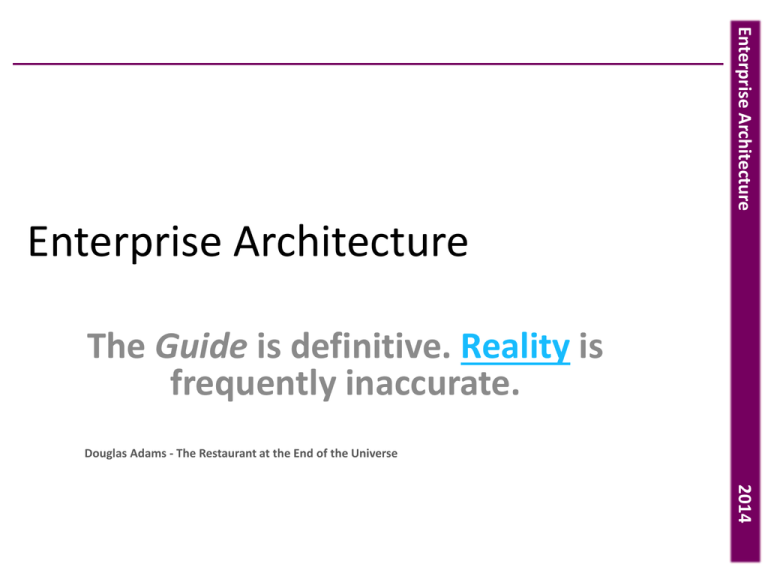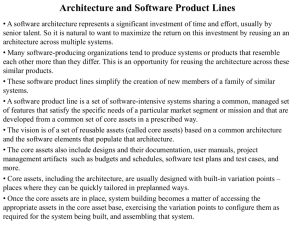Enterprise Architecture: The Guide is difinitive
advertisement

Enterprise Architecture Enterprise Architecture The Guide is definitive. Reality is frequently inaccurate. Douglas Adams - The Restaurant at the End of the Universe 2014 – Enterprise Architecture (EA) at UC • • • • • • • Overview Domains Team Roadmap Objectives EA Services Value of EA Enterprise Architecture Webinar Topic 2014 2 A methodology for developing and using architecture to guide the transformation of a business from a baseline state to a target state Enterprise architecture is the organizing logic for business processes and IT infrastructure reflecting the integration and standardization requirements of the company's operating model . . . the documented results after examining the enterprise . . . 2014 Models describing the logical business functions or capabilities, business processes, human roles and actors, the physical organization structure, data flows and data stores, business applications and platform applications, hardware and communications infrastructure A comprehensive set of cohesive models that describe the structure and functions of an enterprise Enterprise Architecture What Is Enterprise Architecture? – Part I 3 Enterprise Architecture What is Enterprise Architecture? – Part II 2014 • Enterprise architecture is a practice focused on the alignment of people, process and technology in support of the UC mission, vision and strategy. Enterprise Architecture Enterprise Architecture at UC - Overview – Enterprise architecture describes significant structural components such as information, process, application and technology assets and how they are used to support optimized business execution. 2014 • Enterprise architecture is unique to every organization, however there are some common elements. 5 • The four commonly accepted domains of enterprise architecture are: • EA artifacts are used to define target solutions, capabilities, etc. 2014 • Each domain is described by multiple artifacts: • models • blueprints • processes • capabilities • standards • reference architectures • etc. Enterprise Architecture Enterprise Architecture Domains 6 • Enterprise architecture is focusing on five architectural areas – – – – – SOA (Service Oriented Architecture/Approach) Identity and Access Management Applications Security Data Enterprise Architecture UC Enterprise Architecture Focus Areas 2014 7 Enterprise Architecture Enterprise Architecture Team – June 2014 • Domain Architects work with cadre of systemwide business and technical staff on: 2014 – Identification and development of capabilities, best practices, standards, reference architectures, services, shared or common solutions, etc. 8 • Establish an enterprise architecture for UC that supports the needs of our federated organization • Create the architecture artifacts, locally and systemwide, that describe the desired: – – – – – Enterprise Architecture Enterprise Architecture Objectives Business processes Information assets Technology components Interoperability capabilities, protocols Security posture 2014 • Foster the enterprise architecture discipline at each location 9 • Systemwide Enterprise Architecture is nascent • We start with the fundamentals Enterprise Architecture Enterprise Architecture Roadmap – Basic building blocks • Establish the discipline – Locally, system wide • Services, capabilities – Consistency, reuse 2014 • Innovation 10 • Enterprise Architecture places significant emphasis on reuse, interoperability and service orientation • Reuse leverages existing data, technology and process assets as services. – – – – Minimizing expense on redundant resources Improving quality, consistency, time to delivery Increasing security and management opportunities Improved augmentation potential Enterprise Architecture Enterprise Architecture Modus Operandi • Interoperability facilitates reuse and access to information services by multiple consumers. – Reuse is possible when a shared service is discoverable, reliably available and accessible – A high degree of standardization is required for optimal reuse (e.g., standard protocols, data definitions and structures, etc.) 2014 • Service orientation promotes delivery of services rather than tactical point systems/applications. 11 • Enterprise Architecture services are most often requested for systemwide needs: – Shared Administrative Systems • UCPath – Shared Capabilities • Enterprise Metadata Repository • IdP Proxy Service – Common Capabilities • Integration patterns, standards and protocols • Service design • Service discoverability – Enterprise Data Models • HR & Payroll • Student • Party – Frameworks • Principles, standards • Technology & Tools 2014 • Managed File Transfer (MFT) • Enterprise Service Bus (ESB) – Interoperability Enterprise Architecture Enterprise Architecture Service Examples 12 • The UC business and technology landscape is vast, fragmented and has myriad opportunities for cohesion. • Defining target state architectures and an enterprise roadmap enables the organization to leverage individual projects in a manner that supports long-term business strategies and efficiencies. Enterprise Architecture Recap: Why Enterprise Architecture? • Enterprise Architecture reduces – Redundancy, complexity and information silos – Business risks associated with IT investments • Enterprise Architecture improves Business and technology alignment Consistency in a federated landscape Interoperability and information sharing Return on investment Flexibility and agility 2014 – – – – – • Enterprise Architecture SharePoint site – EA Body of Knowledge (EABoK) • Contains artifacts such as principles, standards, etc. Enterprise Architecture Enterprise Architecture Resources 2014 14 Enterprise Architecture Questions? 2014



